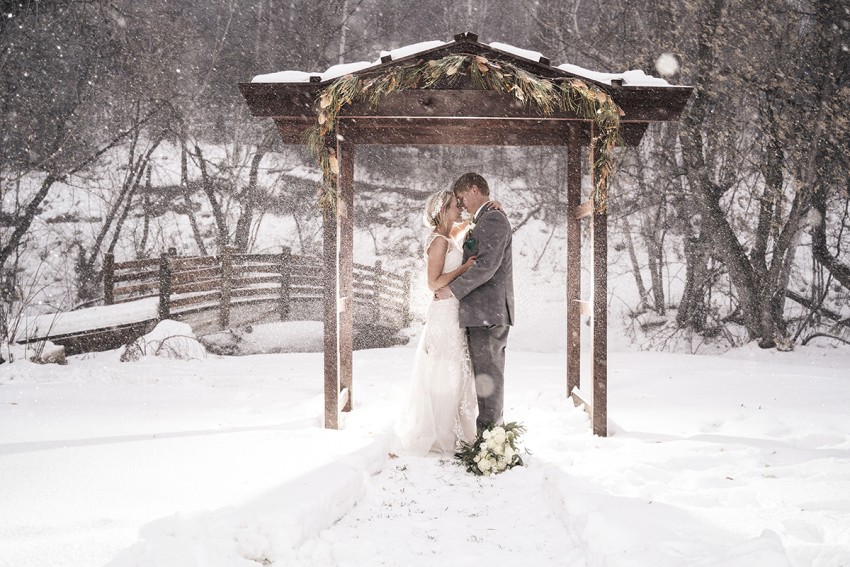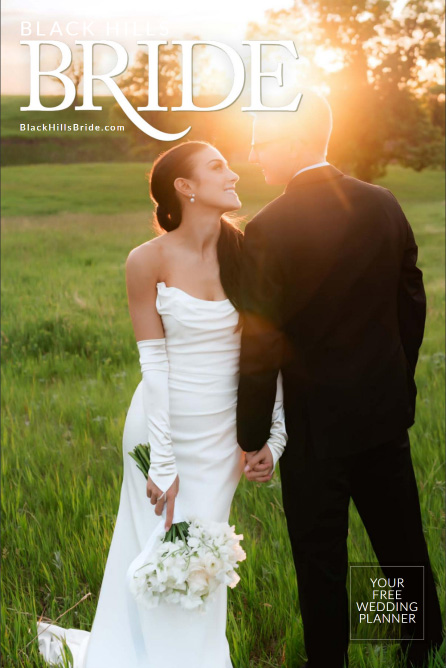Your Guide to Gowns
When you shop the boutiques for your perfect wedding gown, you’ll probably hear more terms for styles, gown shapes, veils and trains than you thought possible.
When you go to your first dress appointment, it goes a lot more smoothly if you're prepared. Knowing basic terms involved with dresses will go a long way, since you'll be able to tell your bridal shop exactly what you're looking for. Learning all of the different options can be overwhelming, but the terms below can help you get started.
Silhouette
Perhaps the most important category when it comes to dresses, the overall shape of the gown is the fastest way to narrow your search. Each of these styles will showcase a different body type, as well as set the style for your shoes and accessories. Here's how to find the one that makes you look and feel gorgeous.
Ball Gown: This is the traditional Cinderella dress. A ball gown has a fitted bodice that flares to a full skirt. Ball gown dresses are appropriate for formal weddings and look great on women with pear-shaped bodies. While the ball gown is timeless, it also lends itself to a more formal wedding style. If you have your heart set on a fairytale wedding, it's the perfect choice!
A-line: Universally flattering for almost every body type, this style has a fitted bodice that gradually tapers into a wider, more flared skirt. This look highlights the narrowness of the midsection and floats away from the hips and thighs. If you're not sure what you want, the A-line is a great place to start.
Empire Waist: Similar to an A-line dress, empires have a fitted bodice that ends just below the bust with free flowing skirts that help lengthen the body’s appearance. This style is popular in more relaxed or casual dresses, think soft, flowing Greek-inspired perfect for a spring wedding.
Mermaid: Perfect for girls with curves, the mermaid has a fitted bodice and a flared skirt. Most skirts will flare out above the knee, but some more modern or dramatic versions will flare closer to the ground into a dramatic train. This style can be formal or more relaxed, and is a little more unexpected than other silhouettes.
Sheath: These sleek and sophisticated column dresses are form-fitting from top to bottom and have no waist. The style either hugs the natural curves of the body, or falls in a straight line from the shoulders to the hemline. Sheath dresses can be dressed up for a black tie affair, or down for the perfect garden wedding.
Separates: More designers are offering two-piece dresses, where the bodice and skirt are separate pieces. Most of the above silhouettes are available, with the added ability of changing up your look with ease. This is a great option for brides who want a full gown for the ceremony and a smaller, more manageable skirt for dancing at the reception. This super versatile option allows you to create a look that's uniquely you!
Jumpsuits: Another newer trend, jumpsuits are an option that brides may consider for a more casual wedding, or as a second outfit to change into for the reception or get-away at the end of the night. Jumpsuits are modern and trendy, and come in a variety of styles, but most are fitted to show off the bride's figure.
Neckline Styles
After picking the silhouette, necklines and hem lengths are the next biggest factors in the style of your dress. When picking a neckline, keep in mind what kind of jewelry you plan on wearing. Not all necklines and necklaces mesh well together! If you already have your jewelry picked out, be sure to bring it with you to fittings so you can see exactly how it will look.
Bateau or Boat Neck: This classic style has been revitalized since Meghan Markle wore it in her wedding to Prince Harry. It follows the curve of the collarbone, creating a slight “u” shape extending to the tip of the shoulders, and often has a vintage feel. It's a great combination of showing a little skin while offering support.
Halter: A halter neckline is great for brides who want to show off their shoulders and back but have plenty of front coverage. This is a great option if you want a dress with a low back, as the high front will balance it out. For an added fun element, consider a keyhole, which is a gap in the fabric underneath your bust.
High Neck: A classic style made famous by Grace Kelly, this neckline reaches the bottom of the neck, or extends slightly above it. This style can be traditional, but many designers combine it with an illusion neckline to soften the look.
Illusion: Transparent panels extend from the top of the bodice to the neck or shoulders to add the illusion of a strapless dress or support for a deep plunging neckline. Some will also have rhinestones or lace added to the transparent panels to create a unique but airy look. Kate Middleton's wedding dress is a great example of an illusion neckline.
Off-Shoulder: Perfect for a beach or bohemian-style wedding, this neckline sits below the shoulders to draw attention to neck and collarbone. It's similar to a strapless but adds a soft romantic element.
One Shoulder: Channel your inner goddess with this neckline, which features only one strap or sleeve with the opposite arm and shoulder exposed. Often more relaxed or casual, this style brings attention to your face while.
Portrait: Similar to an off-shoulder, the portrait neckline sits below your shoulders but still offers structural support to the gown. This timeless look is perfect to show off statement jewelry while maintaining a flattering, vintage feel.
Straight: Most often seen on strapless dresses, this neckline is a great choice to show off toned shoulders or statement jewelry.
Square: This is a great option if you want to lengthen the appearance of your torso and slim your shoulders. The straight neckline can be cut modestly near the collarbones or lower for a more daring look.
Sweetheart: Shaped exactly like the name says, the sweetheart resembles the top of a heart. It's a great way to add shape but gives you a longer and leaner appearance. Romantic and fresh, this is a classic look. If you want the sweetheart look but need the support of straps, consider the similar Queen Anne neckline.
V-Neck: Ranging from a slight dip to a dramatic diving neckline, v-necks are great for lengthening your torso and highlighting your shoulders. They can also add drama to your look while still offering plenty of support.
Hem, Train, and Veil Lengths
These three features have a simple rule of thumb: the longer the length, the more formal the look. When discussing these with your bridal consultants, keep in mind that most dresses can be altered to go shorter, but adding length can be tough and cost a pretty penny. If you love a dress but wish it didn't have a train, it's a fairly easy fix to have done.
Common hem lengths from shortest to longest:
Mini: Cuts off just above the knee.
Tea: Hits between the knee and ankle.
Ballerina: At or just above the ankle.
Floor: Brushing the floor or slightly above.
Hi-lo: Hits at mid-calf in front and is floor length in back.
Train lengths from shortest to longest:
Sweep: Just grazes the floor behind the bride.
Court: Extends 1-2 feet behind the gown.
Chapel: Extends 3-4 feet behind the gown.
Cathedral: Extends 6-8 feet behind the gown.
Watteau: Attaches at the shoulders and falls to the hem or slightly longer.
Pro tip: If your dress has a train, talk to your seamstress about bustling it. There are several options that are easy to add to your train, and will make getting busy on the dance floor much easier. Be sure to take someone with you to learn how it's done so they can help you on your wedding day.
Veil lengths from shortest to longest:
Birdcage: A short veil of netting or transparent material, usually attached by a fascinator or comb into your hair. Can cover just your eyes or your full face.
Blusher: Short but still traditional and usually about 30 inches long, this veil will cover your face and end near your shoulders or top of your dress. Known as a blusher as it has to be flipped up during the ceremony to reveal the blushing bride's face.
Elbow: A medium length that falls to—you guessed it–the bride's elbow.
Fingertip: Another cleverly named length, this veil will come down to your fingertips. It balances coverage while still remaining semi-formal; the advantage over an elbow length is it won't disrupt the view of a gown with an intricate back.
Knee-length: This veil offers drama and elegance without being too long and cumbersome. It's a great choice for a formal look without being weighed down.
Floor-length: A long veil that just grazes the floor and should match the length of your dress if you don't have a train.
Chapel: A great way to get the look of a long train that can be easily removed for the reception, chapel veils extend slightly longer than the hem of a floor-length gown.
Cathedral: The name came from the regal nature of these veils, as they extend past the train of your gown and can be as long as you like.
When choosing a veil, or any accessory, try on multiple lengths, colors, and styles or levels of embellishment. Keep in mind all of your accessories, as well. Certain veils like a birdcage allow statement necklaces or earrings to shine, where a longer veil can add a level of drama to an otherwise simple dress.


